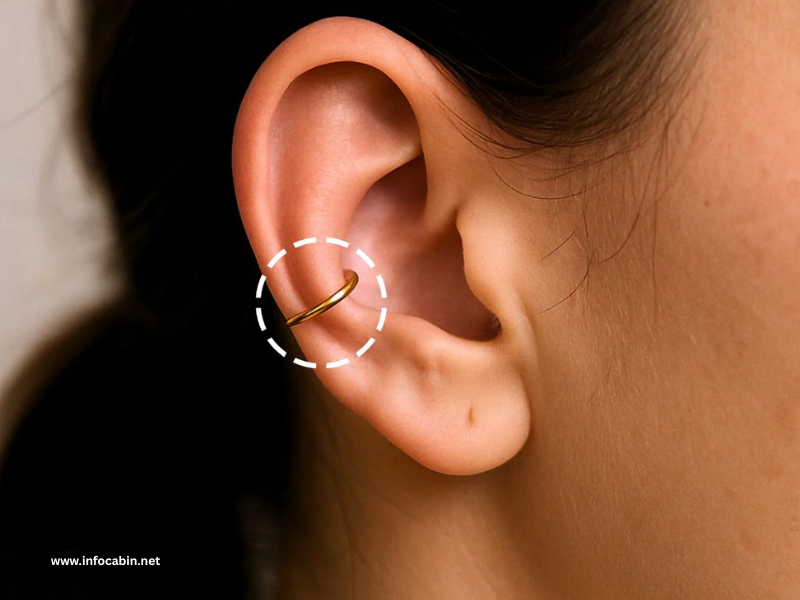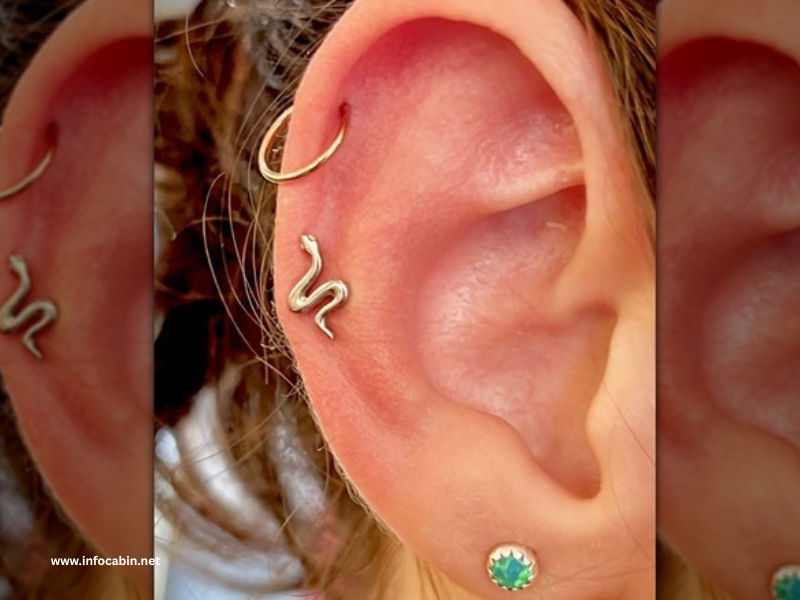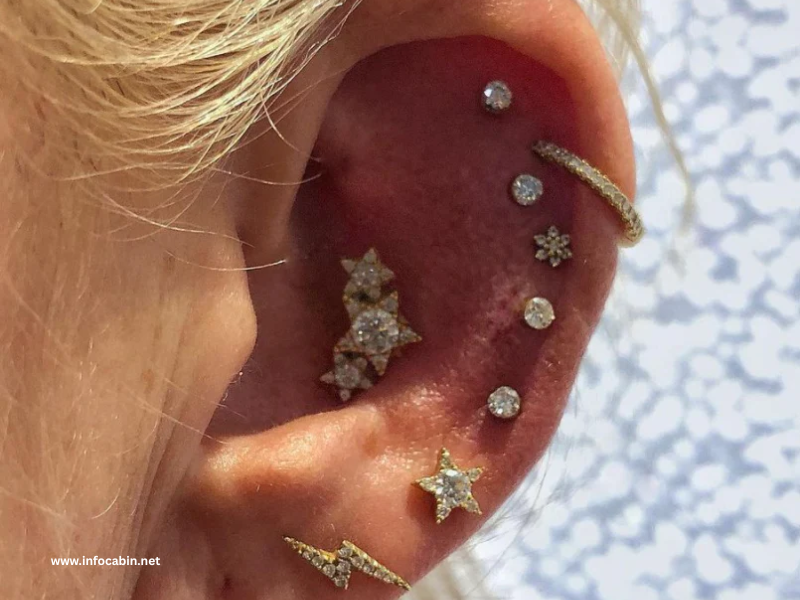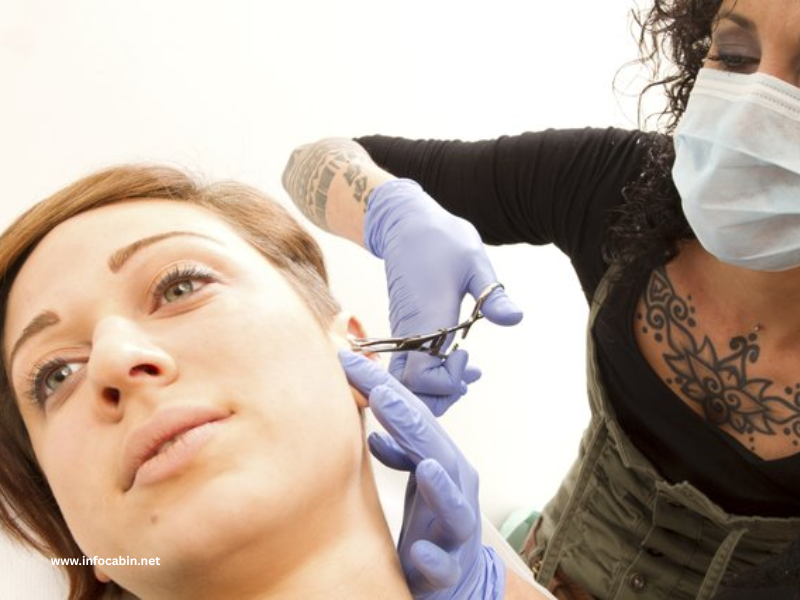Thinking about leveling up your ear jewelry game? An auricle piercing might be exactly what you need. Sitting perfectly between the lobe and the upper cartilage, the auricle is a prime spot for hoops, studs, or stacked piercings. It strikes the balance between subtle and bold, making it a favorite among piercing enthusiasts.
This complete guide covers everything—placement, pain, healing, jewelry options, aftercare, styling tips, and myths—to help you decide if the auricle piercing belongs in your curated ear.
Table of Contents
What Is an Auricle Piercing?
An auricle piercing is a type of cartilage piercing placed on the outer rim of the ear, midway between the lobe and the helix. Think of it as the “middle child” of ear piercings—it connects the classic lobe to the bold upper cartilage.
Because of its location, the auricle piercing offers the best of both worlds: it’s more eye-catching than a lobe piercing, yet not as dramatic as an industrial or snug. It works beautifully in minimalist stacks or as part of a bold ear constellation.
Why Choose an Auricle Piercing?

Aesthetic Appeal
The auricle is a sweet spot that allows both hoops and studs to shine. A single hoop can hug the ear’s curve, while a row of studs can create a dotted-line effect.
Versatility
Whether you’re into minimalism or maximalism, the auricle adapts. It looks chic on its own, but also complements helix, conch, and lobe piercings.
Balanced Placement
Because it sits midway, it naturally balances an ear full of jewelry, tying the upper and lower piercings together seamlessly.
Anatomy & Placement
Where Exactly Is the Auricle?
The auricle is the outer middle rim of the ear. It runs between the helix (upper ear rim) and the lobe.
Single vs. Multiple Auricle Piercings

Single auricle: One stud or hoop, subtle and chic.
Double auricle: Two aligned piercings stacked vertically or horizontally.
- Triple auricle: A constellation effect, perfect for a trendy “ear party.”
Pain Level: Does an Auricle Piercing Hurt?

- The moment of piercing: A sharp pinch lasting 1–2 seconds.
- Afterward: Some throbbing or pressure for a few hours.
- Ongoing: Tenderness when touched or slept on during early healing.
Healing Time & Stages
How Long Does It Take to Heal?
The auricle piercing usually takes 3–9 months to fully heal, though everyone’s timeline varies. Cartilage generally heals slower than lobes.
Healing Stages
Week 1–2
- Swelling, redness, and crusting are normal.
- Tender to touch.
Month 1–3
- Tenderness decreases, but avoid heavy pressure.
- Jewelry should not be changed yet.
Month 3–6
- Piercing stabilizes, but occasional irritation is possible.
Month 6–9+
- Full healing, ready for jewelry changes if cleared by a piercer.
Red Flags to Watch For
- Hot, spreading redness
- Pus with a foul odor
- Severe swelling or embedded jewelry
If these occur, see a professional piercer or medical provider.
Best Jewelry for Auricle Piercings

Starter Jewelry Options
- Captive Bead Ring (CBR): Classic hoop that hugs the ear’s curve.
- Flat-Back Labret Stud: Great for a “floating” effect.
- Seamless Ring: Minimalist and sleek.
Jewelry Materials
- Implant-Grade Titanium: Best starter material—lightweight and hypoallergenic.
- 14k/18k Solid Gold: Safe once healed, stylish long-term option.
- Niobium: Hypoallergenic with colorful anodized finishes.
- Surgical Steel: Durable but may cause issues for those with nickel sensitivity.
Gauge & Size
- Gauge: Usually 16g (1.2 mm) or 18g (1.0 mm).
- Diameter: 8–10 mm hoop is common, depending on ear size.
Cost of an Auricle Piercing
The price depends on location, piercer experience, and jewelry choice.
- Piercing fee: $30–$70
- Jewelry: $40–$150+
- Total cost: $70–$200+
Always invest in high-quality jewelry for safe healing.
Choosing the Right Piercer

What to Look For
- Portfolio: Check healed auricle placements.
- Jewelry Standards: Implant-grade only.
- Studio Hygiene: Autoclave sterilization is non-negotiable.
- Experience: Ask how often they perform auricle piercings.
The Piercing Procedure
- Consultation: Piercer examines your ear anatomy.
- Marking: They mark placement for balance and alignment.
- Cleaning: Ear is disinfected.
- Piercing: Single-use needle passes through cartilage.
- Jewelry insertion: Starter piece is inserted.
Pro tip: Avoid piercers who use piercing guns on cartilage—needles are safer and cleaner.
Aftercare for an Auricle Piercing
Daily Care
- Clean 2x daily with sterile saline spray.
- Pat dry with clean paper towel—avoid cotton balls.
- Hands off! Don’t twist or rotate jewelry.
What to Avoid
- Sleeping directly on the piercing
- Swimming in pools or hot tubs early on
- Over-ear headphones that put pressure on the area
Healing Boost Tips
- Use a travel pillow to avoid pressure when sleeping.
- Tie hair back to keep strands from snagging.
- Keep skincare and haircare products away from the piercing.
Downsizing & Jewelry Changes
- Downsizing: After swelling goes down (4–8 weeks), your piercer may replace your jewelry with a shorter post for comfort.
- Switching Styles: Wait until at least 6 months, or until your piercer confirms full healing.
Common Issues & Troubleshooting
Irritation Bumps
- Caused by friction, sleeping on it, or jewelry that’s too tight.
- Solution: Consult your piercer for downsizing or jewelry adjustment.
Hypertrophic Scarring
- Raised bump around piercing site.
- Usually improves with proper aftercare.
Keloids
- Rare but possible; these extend beyond the piercing site.
- Seek medical advice if you suspect one.
Styling Inspiration
Minimalist Auricle
- Tiny gold or silver hoop hugging the rim.
- Dainty stud for a floating look.
Stacked Auricle
- Double or triple piercings lined up for symmetry.
- Great for creating a constellation ear.
Statement Auricle
- Bold hoop with charms or gemstones.
- Decorative rings that connect to other piercings.
Combining Auricle With Other Piercings
- Auricle + Helix: Creates a balanced upper-to-middle look.
- Auricle + Conch: Hoop combinations for layered curves.
- Auricle + Lobe Stack: Smooth transition from lower to upper ear.
Myths About Auricle Piercings
“It Heals as Fast as a Lobe Piercing”
False—cartilage healing takes months, not weeks.
“You Can Change Jewelry After a Month”
No—changing too soon risks infection and bumps.
“Any Piercer Can Do It”
Not true—cartilage piercings require skill and precision.
Long-Term Maintenance
- Clean jewelry occasionally after healing.
- Remove and check hoops for tight closures.
- Avoid leaving the piercing empty for extended periods—it may shrink.
Conclusion
An auricle piercing is versatile, stylish, and a perfect middle-ground piercing for anyone wanting to upgrade their ear game. With the right jewelry, proper aftercare, and a skilled piercer, it can become a centerpiece of your curated ear or blend seamlessly into a subtle look.
FAQs
Q1. How painful is an auricle piercing?
Most people rate it a 4–6/10. Less painful than a snug or rook, more than a lobe.
Q2. How long until I can change my jewelry?
Usually 6–9 months, depending on healing.
Q3. Can I wear headphones with an auricle piercing?
Over-ear headphones may cause irritation early on. Opt for in-ears during healing.
Q4. Do auricle piercings close if removed?
Yes, especially if new. Even healed piercings can shrink if left empty.
Q5. What’s the best jewelry for an auricle piercing?
A titanium or solid gold hoop or flat-back stud for a safe and stylish fit.

